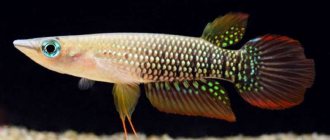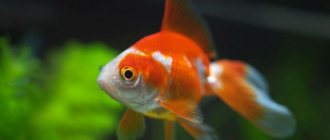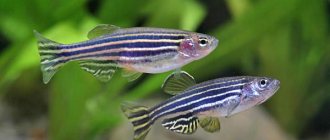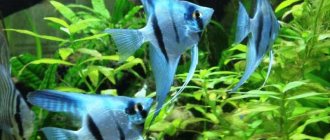In the depths of the African continent, almost in its very south, there is a freshwater lake Malawi. Stretching for hundreds of kilometers, it is the 9th largest in the world and contains about 7% of all fresh water on earth. The unique ecosystem of the isolated reservoir includes dozens of species of living organisms not found anywhere else. Melanochromis maingano, a small blue fish, is one of them.
Melanochromis maingano, a small blue fish, lives only in Lake Malawi, Africa.
Life in the wild
Melanochromis maingano is endemic. This means that in the wild, these fish live in only one place on the globe - in Lake Malawi, located near the island of Likoma. The fish is named after the area around the lake. Among aquarists, Melanochromis maingano is called the blue johanni, and the inhabitants of Africa call it chisumulu johanni.
In lake waters, the fish prefers to live in the middle and upper layers, not falling to a depth of less than 20 meters. Favorite habitats are rocky shores. This love for the accumulation of stones and rocky surfaces is dictated by anatomical features - melanochromis have a special jaw structure, thanks to which they scrape moss and algae from rocky surfaces, which are their main source of food. In addition to plant foods, Mainganos love phyto- and zooplankton.
Melanochromis maingano was discovered as an independent fish species quite recently (in 1997), thanks to scuba divers who became interested in the underwater world of Lake Malawi and studied its flora and fauna. The fish is not of interest to people as a fishery, but due to the fact that aquarists have become massively interested in melanochromis, their numbers in the wild have recently decreased sharply.
Communication skills
Due to the fact that the dominant male is very aggressive, he will always be the “boss” in the aquarium. In order to reduce the aggressive mood, you need to destroy the boundaries of his territory and fill the aquarium to the maximum
The presence of fish of a different species will distract attention, so cruelty towards its relatives will dissipate a little
The existence of two males, even in a large aquarium, will be at risk, since the less dominant male will most likely be killed.
To reduce persecution from the male, several females need to be counted on him, but even in small aquariums, they can be subjected to a fatal beating.
Appearance Features
Melanochromis cannot boast of excessively large sizes. In an aquarium they grow from 7.5 to 10 cm, but in their natural habitat they reach no more than 7.5 cm. The main body color is blue with dark shades. There are 3 white stripes on the body. White ones run along the dorsal fin, and between them there are dark stripes.
The body shape is elongated, the dorsal fin is solid and long. The anal, dorsal and ventral fins are spiny at the ends. The nose is rounded with large, massive nostrils, with which the fish draws in water and after a while exhales it back. This is necessary in order to find food by smell.
In addition, the jaw - it has several incisor teeth located close to each other. The first association that comes to mind when you look at Melanochromis maingano is a rocket, at the end of which yellow, large and expressive eyes . It is because of them that the fish always seems sad.
Sexual differences in individuals are weakly expressed. Males have 4 dark stripes between light lines, and females have 3. The length of the fin on the abdomen also differs in females - it is slightly shorter. Another difference that only an experienced aquarist can determine is the presence of small light spots on the anal fin of males, similar to grains of caviar. When spawning occurs, the color of the females fades, while the males, on the contrary, become very bright.
Description
A small cichlid, it has an elongated body with a rounded nose. In the oral cavity there are incisors designed for cutting hard algae from stones. A low fin stretches almost along the entire back. The main color is dark blue with two blue horizontal stripes. The fins and tail are edged with a thin blue stripe. Its body shape and coloration is similar to its close relative Melanochromis johana, which has often led and still leads to confusion.
Keeping in an aquarium
In order for Melanochromis maingano to feel as comfortable as possible in an artificial pond, it needs a tank with a volume of at least 120 liters; it’s good if it’s larger, but not smaller. Coral chips are used to cover the bottom, maintaining a certain acidity of the water. Sea sand, sifted, will also work.
The aquarium must have decorative elements: stones and grottoes, rocks so that moss collects on them and algae grows, which the fish will eat.
Melanochromis maingano is not particularly whimsical and demanding regarding aquarium vegetation, so you can choose them at the request of the aquarist himself.
It is recommended to plant crops on the opposite side of rocks and stones. Stones, grottoes and other decorative elements should be securely fixed to the bottom, since the fish really likes to dig up the soil. If the stones are poorly secured, the melanochromis may touch them with its nose and they will fall on it.
Required water parameters:
- temperature regime – +22° – +28°C;
- degree of hardness – medium, from 6 to 10 units;
- pH value – from 7.7 to 8.6;
- frequency of water changes - every week from 20 to 50%.
Cichlids like slightly salted water, but the salt content should not exceed 1.0002 units. or 2 g per 1 liter of water. Melanochromis maingano cannot be called too picky aquarium inhabitants, but maintaining water parameters at the same level is very important, otherwise the fish will get sick.
Cichlids love clean water, so if they dig too intensively and the water quickly becomes dirty, it needs to be changed more often, as needed. A filter will help maintain the purity of the liquid in the artificial tank, which the aquarium must be equipped with. Lighting should be moderate. It is recommended to siphon sand and coral chips once every 7 days (read more about how to properly siphon soil in an aquarium).
What to feed melanochromis
Melanochromis maingano is unpretentious in food. It is recommended to build the diet according to the following principle - 60% plant food and 40% live food. Fresh, frozen and specialized dry diets are suitable for the latter. Suitable for Melanochromis maingano:
- gammarus;
- Daphnia;
- cyclops;
- ciliates;
- live dust;
- rotifers;
- bloodworm;
- crustaceans;
- spirulina.
There must be enough algae in the aquarium for the fish to eat it. In addition, it is recommended to periodically introduce complementary foods consisting of pieces of zucchini and cucumber. It is important to provide Melanochromis Maingano with high-quality and varied nutrition, otherwise it will get sick.
From time to time, in order to maintain good health of your pet, it is recommended to give specialized dry food containing all the necessary minerals and vitamins. You should feed the fish 2 times a day, and 5 minutes after feeding, remove the remaining food from the aquarium; this measure will help keep the water clean longer.
Nutrition
Omnivorous, accepts all types of dry and frozen food with herbal supplements. The diet should be varied; feeding only one type of food is not acceptable. The optimal composition is as follows: frozen or live foods (insect larvae, bloodworms, small crustaceans) combined with plant flakes, such as spirulina or other cichlid supplements. Specialized foods for various groups of cichlids are widely available on sale (in retail or online), which contain all the necessary vitamins and microelements. Feed two to three times a day in an amount that will be eaten within 5 minutes, the remains should be removed to avoid contamination of the water.
Behavior and compatibility with other aquarium species
Melanochromis maingano is a rather unsociable species, so it is recommended to keep them in a species aquarium. Males are more endowed with aggressive character traits, this is especially evident during the spawning period. Males can attack not only fish of another species, but also their fellow tribesmen.
Considering that there can be constant skirmishes between males, even bloody battles, it is recommended to keep a small flock of Melanochromis maingano, consisting of one male and several females, in a species aquarium. If you still want to keep cichlids in a large aquarium with other species, it is recommended to choose the following as neighbors:
- cobalt zebra;
- orange lamprologus;
- cuckoo catfish;
- synodontis multispotted;
- Aulonocara Freiberg.
It is not recommended to keep Melanochromis maingano and similar species of cichlids in the same aquarium. Such a neighborhood will end not only in frequent fights, but also in the fact that similar species of cichlids will mate with each other, violating the purity of the species.
Development and reproduction
In artificial tanks, breeding melanochromis does not cause any difficulties. It is very interesting to watch representatives of this species during spawning. As soon as the mating season begins, males acquire a bright color, females, on the contrary, turn pale.
The white specks on the male's tail are perceived by the female as eggs, so she swims up to him, opens her mouth wide and tries to swallow the tail. Until this moment, the female has already managed to lay up to 10 eggs, which she holds in her mouth. When the female opens her mouth wide at the male's tail, he releases seed to fertilize them.
During the entire incubation period, which lasts a fairly long period of time compared to other fish (about 3 weeks), the eggs are in the female’s mouth.
The newly born fry, until they become independent, use the female’s mouth as a shelter. More males are usually born.
The fry should initially be fed with “live dust”. When they grow a little and reach a length of 3-4 cm, which is about 6 weeks from the moment they are born, you can give food as for adult fish, but grind it thoroughly.
If Melanochromis maingano live in a species aquarium in a small flock consisting of 1 male and several females, spawning can be carried out directly in the same tank. If there are several males or there are neighbors of other species, the spawning pair should be placed in a separate tank - a spawning tank, with the same conditions and water parameters as in a common aquarium.
Breeding
If you create suitable conditions for these pets, then getting offspring will not be difficult. This can even happen in a community aquarium. But, of course, it is advisable to prepare a depositor.
To stimulate spawning, you need to raise the temperature of the water in the aquarium. The female who will lay eggs swims into the male’s territory, where he fertilizes her. Then the female collects the eggs in her mouth and carries them for 2-3 weeks, which is not an easy test for the fish. The young stay close to the mother for another 2-3 months, as she protects the fry from threats and, thus, the next generation survives in fairly large numbers.
Health and susceptibility to certain diseases
Melanochromis maingano is a fairly physically strong species of aquarium fish that is not prone to any diseases. They are distinguished by good health and good endurance, but on the condition that in the aquarium they are provided with all the necessary parameters that are as close as possible to their natural living conditions in the wild.
The life cycle of the African cichlid averages from 7 to 10 years.
However, there is evidence of long-lived fish living in aquariums for up to 25 years, but this is an exception to the rule. Melanochromis maingano can react negatively to changes in the biochemical parameters of water. If the fish has become pale and lethargic, you must first check whether the temperature and other parameters of the aquatic environment have changed.
Changes in the behavior and well-being of fish can also be caused by poor nutrition. If the diet is incorrect and unbalanced, melanochromis can get sick. As soon as all the necessary water parameters and proper nutrition are restored, the pet will begin to gradually recover and will again begin to dig the soil with its nose with curiosity.
Diseases
The main cause of most diseases of Malawian cichlids is unsuitable housing conditions and poor-quality food, which often leads to a disease such as Malawi Bloat. If the first symptoms are detected, you should check the water parameters and the presence of high concentrations of hazardous substances (ammonia, nitrites, nitrates, etc.), if necessary, bring all indicators back to normal and only then begin treatment.
The post Melanochromis chipoka: maintenance, care, breeding, feeding, compatibility, photos, videos appeared first on AQUARIUM FISH.
Is it worth buying Melanochromis maingano?
The decorative species Melanochromis maingano, discovered relatively recently for aquarists, began to quickly gain popularity. Such a wide distribution is explained by the fact that these fish are completely unpretentious in care, there is no need to create complex, specific living conditions for them, and therefore they can be kept not only by experienced aquarists, but also by beginners who have no skills in aquarium keeping.
Melanochromis maingano are wonderful fish in all respects. They attract attention with their bright colors. They are also very fun to watch as they are funny and playful. With proper maintenance and nutrition, melanochromis will delight the aquarist for a long time with their good health and regular spawning. You can purchase them at any pet store at a reasonable, affordable price. It is recommended to keep these cichlids in a species aquarium in a small flock, but representatives of this species will also feel comfortable in a common tank of sufficient volume with the right choice of neighbors.











